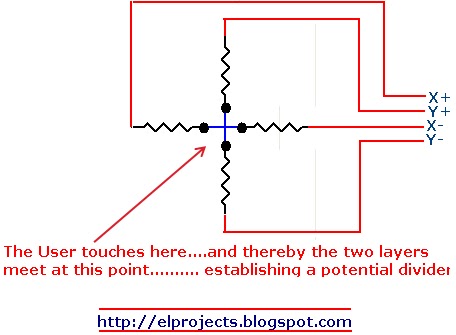A resistive touchscreen (4-wire) looks like this as a schematic:

To read an X position, you put voltage across X+ and X- and then read the voltage between EITHER Y pin and ground. How does the Y position of the touch not affect the reading?
Example, you put a voltage to V+ and ground V-. You press in the centre of X at the very top of the screen. So the values of East and West are equal, but North is zero and South is large. The voltmeter (or ADC in the real world) is placed across Y+ and ground, which is the same as X-. The measurement shows the voltage across East, which is what we want.
Now you press in the centre at the very bottom of the screen. South is now in series with the voltmeter, is it not? I'm still pretty green at electronic theory, but why doesn't this affect the reading? TL;DR stop reading now if that is clear, the rest is explaining because I'm not sure if it is.
To put it another way, I hope I'm not repeating myself unnecessarily, but in the below image, the measurement I WANT is assumedly the voltage across X1, but I can't get that without incorporating X4.
I can't find anything to explain the effect of a resistor in series with a voltmeter, if you can point me to that it might answer my question.
Also am I correct (in this particular case) to treat an ADC as a voltmeter? The output from the ADC is over SPI, and I've got that part sorted, so I'm treating measuring the ADC output (0-1024) as the same thing as reading the voltage (0-3.3V). If I'm wrong here, this is out of scope for this question but I'd appreciate the nudge to stop me running in to a different problem.

